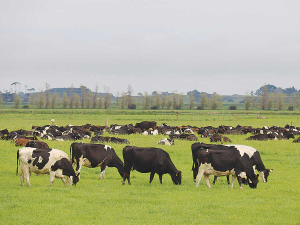Westpac expands community banking with new vans and extended branch hours
Westpac NZ has announced new initiatives that aim to give customers more options to do their banking in person.
 Grass growing conditions over the summer months will be another key variable to this season’s milk price.
Grass growing conditions over the summer months will be another key variable to this season’s milk price.
Dairy prices dipped last week after three consecutive rises but economist Nathan Penny, Westpac, says the dip is likely to be temporary.
He says it’s assumed that the 2% drop in Global Dairy Trade’s whole milk powder prices last weeks is Covid-related.
Global daily cases have hit fresh record highs recently, forcing parts of Europe to go back into lockdown.
Penny says these developments are likely to dampen global dairy demand and thus prices, at least temporarily.
“With that in mind, we note that China and the rest of Asia have led the rebound in dairy demand and prices, and on that front, Covid developments are more benign.
“Accordingly, we anticipate that the dip in dairy prices is likely to prove temporary.”
Last week’s price dip surprised the market with the futures market forecasting a 1% rise.
ASB economist Nathaniel Keall says while there is some disappointment to see the winning streak end at the auction, prices are moving less dramatically than they were earlier in the year.
“Back then we saw some real rollercoaster moves up and down,” says Keall.
Keall notes that GDT volumes remain stubbornly down on year-ago levels. The total volume sold at last week’s auction fell about 8% compared to the same time last year. Volumes sold have been down on year-ago levels at every auction since the beginning of July, after rising sharply earlier in the year as buyers rushed to secure supply amid fears of wide-scale Covid-related supply chain disruption and a slowdown in international trade.
He says the shape of the contract curve is shifting too.
“Over recent auctions there has been a bit of a ‘kink’ in the curve, with demand for nearer-dated contracts much higher.
“At the latest auction, the curve shifted in the opposition direction, with demand lower at the nearer term and then rising out to longer dates.”
He says this might suggest buyers have built up good stockpiles for the time being after the lifts over recent auctions.
ASB is retaining its $6.75/kgMS forecast for the 2020-21 season.
Watching how grass grows
Grass growing conditions over the summer months will be another key variable to this season’s milk price, says Nathaniel Keall, ASB economist.
Last month NIWA released its seasonal outlook for the beginning of summer, confirming that New Zealand is highly likely to experience La Niña weather conditions.
Keall says La Niña conditions are typically associated with above average temperatures across the country and near-normal rainfall conditions in the upper North Island, but can also mean lower-than-average rainfall in the rest of the country.
“That should mean grass growing conditions are good in the Waikato but much weaker elsewhere.
“Milk production is currently running about 3% of last year, and we continue to expect it to finish the season higher, but there is the real risk it could taper off if things really dry-off.”
Three New Zealand agritech companies are set to join forces to help unlock the full potential of technology.
As the sector heads into the traditional peak period for injuries and fatalities, farmers are being urged to "take a moment".
Federated Farmers says almost 2000 farmers have signed a petition launched this month to urge the Government to step in and provide certainty while the badly broken resource consent system is fixed.
Zespri’s counter-seasonal Zespri Global Supply (ZGS) programme is underway with approximately 33 million trays, or 118,800 tonnes, expected this year from orchards throughout France, Italy, Greece, Korea, and Japan.
Animal owners can help protect life-saving antibiotics from resistant bacteria by keeping their animals healthy, says the New Zealand Veterinary Association.
According to analysis by the Meat Industry Association (MIA), New Zealand red meat exports reached $827 million in October, a 27% increase on the same period last year.